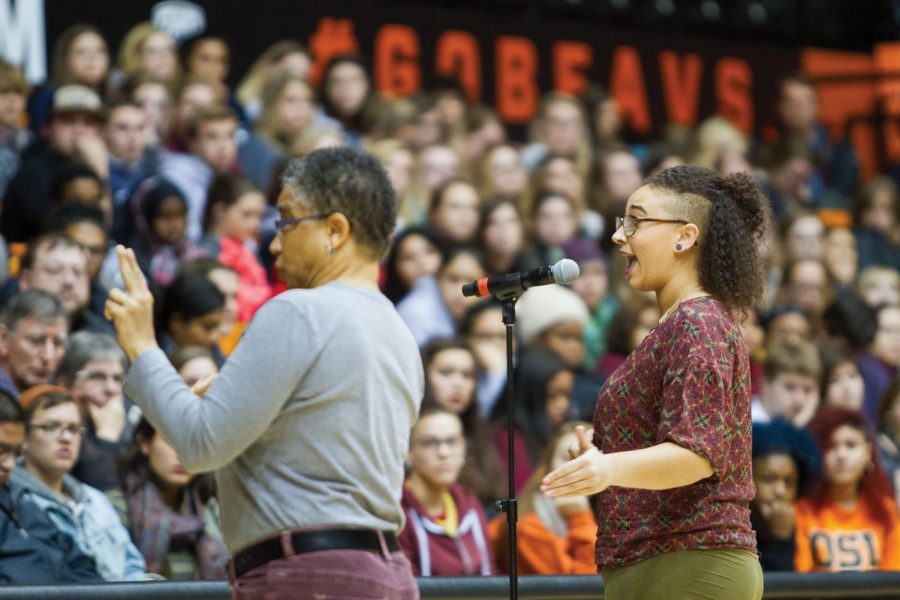Addressing campus equality
November 17, 2015
Speaking out, students at Oregon State University shared their experiences of prejudice and racism on campus in front of hundreds at Gill Coliseum and an audience who watched from home on a live stream.
Experiences shared by student speakers ranged from being questioned about their identity, instructors teaching information that is insensitive to minorities, appropriation or shaming of their culture and even students that felt like their lives are endangered just by being on campus.
Multiple speakers spoke about the hate speech being posted on social media and the live chat as the topics being discussed proved to be controversial. The live chat of the video stream was taken down during the event due to the inflammatory comments posted.
A white man addressed the room off mic saying ‘everyone is a person of color’ near the beginning of the event. His comments were considered problematic by some of the speakers as they believed it did not provide the open space people of color were wanting from this discussion.
OSU students Jesseanne Pope, Jasmine Armas and Haniya Ferrell organized the event in an attempt to generate awareness and to make a direct appeal to faculty and the administration of OSU. Students spoke at the event to request change that would make the campus more inclusive for students of color.
According to Pope, most students of color feel like the university does not offer a place for them to express themselves.
“We want to change the climate on campus so students of color and their experiences can be included and validated,” Pope said.
Erica Fuller, a student leader at OSU, spoke on how she has tried to fight for more inclusivity for students of color.
According to Fuller, the lack of progress the school has made to reach out and institute change that students of color are asking for has been demoralizing.
“I stopped helping the administration; I stopped getting involved; I left all those things,” Fuller said. “I stopped because I got tired fighting for nothing.”
According to Fuller, she feels like faculty here at OSU are not protecting or serving students of color and instead mainly serve white students, and she expressed disappointment for the lack of progress being made.
“I know a lot of administrators can step up, Fuller said.
According to senior Anesat Leon-Guerrero, major in sociology, instructors and administration may not be fully aware of how the content they are teaching in the classrooms can be insensitive and disregard minorities’ viewpoints. She said her instructor diminished her culture and the culture of others by posing a question that seemed to defend Cortez conquering and colonizing an entire ethnic population.
She said during that class she was shaking and sweating, and she did not say anything during class — no one noticed, and not even the teacher until the end of class.
According to Leon-Guerrero, she felt powerless because she was scared to challenge the instructor-student power dynamic.
“These are the types of microaggressions that students of color face,” Leon-Guerrero said. “I would hope and I would assume (the other students) would have seen it or called it out — but they didn’t.”
Leon-Guerrero went on to make a direct appeal to faculty of OSU and how committed they are to supporting students of color.
“Are you just an ally, or are you just an administrator done after 5 o’clock?” Leon-Guerrero said.
Some students gave suggestions that they thought could foster real and long-lasting change. Those ideas included expanding social justice, race relations and ethnic studies and integrate them directly into engineering and STEM classes and by creating more spaces like this event so more people can speak out and share their experiences.
The formal suggestions of change from the student organizers said that OSU should implement mandatory training for staff to focus on identity development and social justice. Organizers also asked OSU to expand readily available campus safety information and to include and highlight research and statistics about racial violence and resources for those affected. Additionally, OSU administrators should name and address the systemic issues preventing the application rate, acceptance rate and graduation rate of students of color.
During the discussion, there were people crying, people’s voices rising in anger or helplessness — It was students of color speaking in front of a mainly white crowd demanding change.
According to Pope, she appreciated the turnout of students of color and white students and she hopes that it can broaden the conversation and continue outside of this forum. Pope said it meant a lot that white students came out and were willing to listen to the stories of the students of color.
After listening to almost two hours of stories about racism, discrimination and prejudice on campus, OSU President Ed Ray gave his closing statements.
“I am sorry for what you have had to endure, the hurt and the pain. If I could take it away in a moment, I would,” Ray said.
According to Ray, some of the college’s attempts at inclusivity have fallen short.
“It’s clear that however good the intentions, however purposeful the programs, we are not getting the job done,” Ray said.
Ray said that the OSU administration has not yet done enough to address the concerns of minority students.
“I am dedicated to make sure that we summarize the things that were said tonight — to have a conversation on how to implement these changes,” Ray said.
baro.news@oregonstate.edu

















































































![Newspaper clipping from February 25, 1970 in the Daily Barometer showing an article written by Bob Allen, past Barometer Editor. This article was written to spotlight both the student body’s lack of participation with student government at the time in conjunction with their class representatives response. [It’s important to note ASOSU was not structured identically to today’s standards, likely having a president on behalf of each class work together as one entity as opposed to one president representing all classes.]](https://dailybaro.orangemedianetwork.com/wp-content/uploads/2025/03/Screenshot-2025-03-12-1.00.42-PM-e1741811160853.png)























